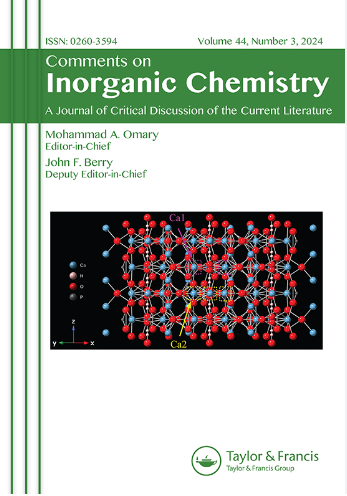自旋交叉系统转变温度的计算模型
IF 3.8
3区 化学
Q1 CHEMISTRY, INORGANIC & NUCLEAR
引用次数: 17
摘要
介绍了计算热化学性质的不同计算方法,特别是自旋交叉(SCO)系统的转变温度(T1/2)。除了计算精确值的可能性之外,这项工作的重点是使用计算工具来解释SCO分子不同家族的趋势。理解化学修饰(电子和空间)对金属中心周围配体场的影响是使T1/2中观察到的趋势合理化的关键。利用分子轨道理论的概念,结合计算结果,可以简单而准确地描述T1/2的位移。因此,提出的结果允许合理设计具有定制特性的新SCO系统。本文章由计算机程序翻译,如有差异,请以英文原文为准。
Computational Modeling of Transition Temperatures in Spin-Crossover Systems
A survey of different computational approaches to compute thermochemical properties and, in particular, transition temperatures (T1/2) in spin-crossover (SCO) systems are presented. Asides from the possibility of computing accurate values, this work centers its efforts in the use of computational tools to explain trends in different families of SCO molecules. Understanding the impact that chemical modifications (both electronic and steric) have over the ligand-field around the metal center is key in rationalizing the observed trends in T1/2. By using concepts from molecular orbital theory combined with the results from the calculations, a simple yet, accurate depiction of the shift in T1/2 can be outlined. Therefore, the presented results allow for a rational design of new SCO systems with tailored properties.
求助全文
通过发布文献求助,成功后即可免费获取论文全文。
去求助
来源期刊

Comments on Inorganic Chemistry
化学-无机化学与核化学
CiteScore
9.00
自引率
1.90%
发文量
18
审稿时长
>12 weeks
期刊介绍:
Comments on Inorganic Chemistry is intended as a vehicle for authoritatively written critical discussions of inorganic chemistry research. We publish focused articles of any length that critique or comment upon new concepts, or which introduce new interpretations or developments of long-standing concepts. “Comments” may contain critical discussions of previously published work, or original research that critiques existing concepts or introduces novel concepts.
Through the medium of “comments,” the Editors encourage authors in any area of inorganic chemistry - synthesis, structure, spectroscopy, kinetics and mechanisms, theory - to write about their interests in a manner that is both personal and pedagogical. Comments is an excellent platform for younger inorganic chemists whose research is not yet widely known to describe their work, and add to the spectrum of Comments’ author profiles, which includes many well-established inorganic chemists.
 求助内容:
求助内容: 应助结果提醒方式:
应助结果提醒方式:


